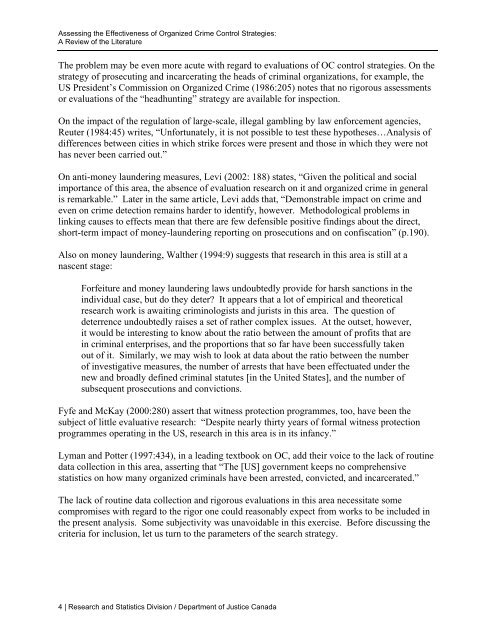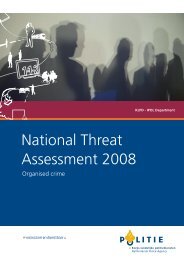Assessing the Effectiveness of Organized Crime Control Strategies ...
Assessing the Effectiveness of Organized Crime Control Strategies ...
Assessing the Effectiveness of Organized Crime Control Strategies ...
You also want an ePaper? Increase the reach of your titles
YUMPU automatically turns print PDFs into web optimized ePapers that Google loves.
<strong>Assessing</strong> <strong>the</strong> <strong>Effectiveness</strong> <strong>of</strong> <strong>Organized</strong> <strong>Crime</strong> <strong>Control</strong> <strong>Strategies</strong>:<br />
A Review <strong>of</strong> <strong>the</strong> Literature<br />
The problem may be even more acute with regard to evaluations <strong>of</strong> OC control strategies. On <strong>the</strong><br />
strategy <strong>of</strong> prosecuting and incarcerating <strong>the</strong> heads <strong>of</strong> criminal organizations, for example, <strong>the</strong><br />
US President’s Commission on <strong>Organized</strong> <strong>Crime</strong> (1986:205) notes that no rigorous assessments<br />
or evaluations <strong>of</strong> <strong>the</strong> “headhunting” strategy are available for inspection.<br />
On <strong>the</strong> impact <strong>of</strong> <strong>the</strong> regulation <strong>of</strong> large-scale, illegal gambling by law enforcement agencies,<br />
Reuter (1984:45) writes, “Unfortunately, it is not possible to test <strong>the</strong>se hypo<strong>the</strong>ses…Analysis <strong>of</strong><br />
differences between cities in which strike forces were present and those in which <strong>the</strong>y were not<br />
has never been carried out.”<br />
On anti-money laundering measures, Levi (2002: 188) states, “Given <strong>the</strong> political and social<br />
importance <strong>of</strong> this area, <strong>the</strong> absence <strong>of</strong> evaluation research on it and organized crime in general<br />
is remarkable.” Later in <strong>the</strong> same article, Levi adds that, “Demonstrable impact on crime and<br />
even on crime detection remains harder to identify, however. Methodological problems in<br />
linking causes to effects mean that <strong>the</strong>re are few defensible positive findings about <strong>the</strong> direct,<br />
short-term impact <strong>of</strong> money-laundering reporting on prosecutions and on confiscation” (p.190).<br />
Also on money laundering, Wal<strong>the</strong>r (1994:9) suggests that research in this area is still at a<br />
nascent stage:<br />
Forfeiture and money laundering laws undoubtedly provide for harsh sanctions in <strong>the</strong><br />
individual case, but do <strong>the</strong>y deter It appears that a lot <strong>of</strong> empirical and <strong>the</strong>oretical<br />
research work is awaiting criminologists and jurists in this area. The question <strong>of</strong><br />
deterrence undoubtedly raises a set <strong>of</strong> ra<strong>the</strong>r complex issues. At <strong>the</strong> outset, however,<br />
it would be interesting to know about <strong>the</strong> ratio between <strong>the</strong> amount <strong>of</strong> pr<strong>of</strong>its that are<br />
in criminal enterprises, and <strong>the</strong> proportions that so far have been successfully taken<br />
out <strong>of</strong> it. Similarly, we may wish to look at data about <strong>the</strong> ratio between <strong>the</strong> number<br />
<strong>of</strong> investigative measures, <strong>the</strong> number <strong>of</strong> arrests that have been effectuated under <strong>the</strong><br />
new and broadly defined criminal statutes [in <strong>the</strong> United States], and <strong>the</strong> number <strong>of</strong><br />
subsequent prosecutions and convictions.<br />
Fyfe and McKay (2000:280) assert that witness protection programmes, too, have been <strong>the</strong><br />
subject <strong>of</strong> little evaluative research: “Despite nearly thirty years <strong>of</strong> formal witness protection<br />
programmes operating in <strong>the</strong> US, research in this area is in its infancy.”<br />
Lyman and Potter (1997:434), in a leading textbook on OC, add <strong>the</strong>ir voice to <strong>the</strong> lack <strong>of</strong> routine<br />
data collection in this area, asserting that “The [US] government keeps no comprehensive<br />
statistics on how many organized criminals have been arrested, convicted, and incarcerated.”<br />
The lack <strong>of</strong> routine data collection and rigorous evaluations in this area necessitate some<br />
compromises with regard to <strong>the</strong> rigor one could reasonably expect from works to be included in<br />
<strong>the</strong> present analysis. Some subjectivity was unavoidable in this exercise. Before discussing <strong>the</strong><br />
criteria for inclusion, let us turn to <strong>the</strong> parameters <strong>of</strong> <strong>the</strong> search strategy.<br />
4 | Research and Statistics Division / Department <strong>of</strong> Justice Canada








